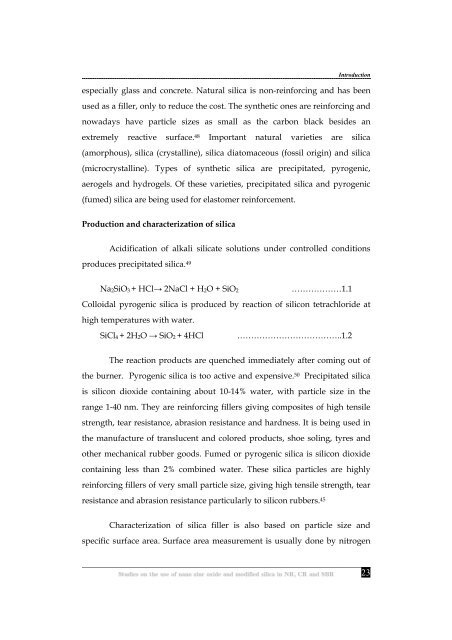Studies on the use of nano zinc oxide and modified silica in NR, CR ...
Studies on the use of nano zinc oxide and modified silica in NR, CR ...
Studies on the use of nano zinc oxide and modified silica in NR, CR ...
Create successful ePaper yourself
Turn your PDF publications into a flip-book with our unique Google optimized e-Paper software.
Introducti<strong>on</strong><br />
especially glass <strong>and</strong> c<strong>on</strong>crete. Natural <strong>silica</strong> is n<strong>on</strong>-re<strong>in</strong>forc<strong>in</strong>g <strong>and</strong> has been<br />
<strong>use</strong>d as a filler, <strong>on</strong>ly to reduce <strong>the</strong> cost. The syn<strong>the</strong>tic <strong>on</strong>es are re<strong>in</strong>forc<strong>in</strong>g <strong>and</strong><br />
nowadays have particle sizes as small as <strong>the</strong> carb<strong>on</strong> black besides an<br />
extremely reactive surface. 48 Important natural varieties are <strong>silica</strong><br />
(amorphous), <strong>silica</strong> (crystall<strong>in</strong>e), <strong>silica</strong> diatomaceous (fossil orig<strong>in</strong>) <strong>and</strong> <strong>silica</strong><br />
(microcrystall<strong>in</strong>e). Types <strong>of</strong> syn<strong>the</strong>tic <strong>silica</strong> are precipitated, pyrogenic,<br />
aerogels <strong>and</strong> hydrogels. Of <strong>the</strong>se varieties, precipitated <strong>silica</strong> <strong>and</strong> pyrogenic<br />
(fumed) <strong>silica</strong> are be<strong>in</strong>g <strong>use</strong>d for elastomer re<strong>in</strong>forcement.<br />
Producti<strong>on</strong> <strong>and</strong> characterizati<strong>on</strong> <strong>of</strong> <strong>silica</strong><br />
Acidificati<strong>on</strong> <strong>of</strong> alkali <strong>silica</strong>te soluti<strong>on</strong>s under c<strong>on</strong>trolled c<strong>on</strong>diti<strong>on</strong>s<br />
produces precipitated <strong>silica</strong>. 49<br />
Na2SiO3 + HCl→ 2NaCl + H2O + SiO2 ………………1.1<br />
Colloidal pyrogenic <strong>silica</strong> is produced by reacti<strong>on</strong> <strong>of</strong> silic<strong>on</strong> tetrachloride at<br />
high temperatures with water.<br />
SiCl4 + 2H2O → SiO2 + 4HCl ………………………………..1.2<br />
The reacti<strong>on</strong> products are quenched immediately after com<strong>in</strong>g out <strong>of</strong><br />
<strong>the</strong> burner. Pyrogenic <strong>silica</strong> is too active <strong>and</strong> expensive. 50 Precipitated <strong>silica</strong><br />
is silic<strong>on</strong> di<strong>oxide</strong> c<strong>on</strong>ta<strong>in</strong><strong>in</strong>g about 10-14% water, with particle size <strong>in</strong> <strong>the</strong><br />
range 1-40 nm. They are re<strong>in</strong>forc<strong>in</strong>g fillers giv<strong>in</strong>g composites <strong>of</strong> high tensile<br />
strength, tear resistance, abrasi<strong>on</strong> resistance <strong>and</strong> hardness. It is be<strong>in</strong>g <strong>use</strong>d <strong>in</strong><br />
<strong>the</strong> manufacture <strong>of</strong> translucent <strong>and</strong> colored products, shoe sol<strong>in</strong>g, tyres <strong>and</strong><br />
o<strong>the</strong>r mechanical rubber goods. Fumed or pyrogenic <strong>silica</strong> is silic<strong>on</strong> di<strong>oxide</strong><br />
c<strong>on</strong>ta<strong>in</strong><strong>in</strong>g less than 2% comb<strong>in</strong>ed water. These <strong>silica</strong> particles are highly<br />
re<strong>in</strong>forc<strong>in</strong>g fillers <strong>of</strong> very small particle size, giv<strong>in</strong>g high tensile strength, tear<br />
resistance <strong>and</strong> abrasi<strong>on</strong> resistance particularly to silic<strong>on</strong> rubbers. 45<br />
Characterizati<strong>on</strong> <strong>of</strong> <strong>silica</strong> filler is also based <strong>on</strong> particle size <strong>and</strong><br />
specific surface area. Surface area measurement is usually d<strong>on</strong>e by nitrogen<br />
23

















